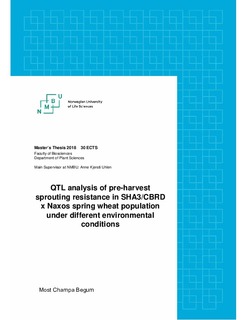| dc.description.abstract | Pre harvest sprouting (PHS) in wheat refers to an untimely germination of mature kernels within the spikes before harvest while still in the mother plant. This is the single most important factor for quality-degradation in wheat around the world as the potential for baking quality is often destroyed by PHS. The major reason for PHS in the field is the lack of adequate seed dormancy when seeds are exposed to wet weather conditions. Due to the significant role of the environment in the PHS damage, wheat breeders are focusing on genetic resistance to control this trait. PHS is a heritable trait, which is maintained by the pleiotropic effect of multiple genes. The main objectives of this study were to identify quantitative trait loci (QTL) for two PHS traits and to investigate the relationship between PHS resistance QTL and QTL for agronomic traits when grown in different environmental conditions. To identify QTL for PHS under different weather conditions, one recombinant inbred line (RIL) population of SHA3/CBRD x Naxos spring wheat was grown at Vollebekk, Norway in 2016 and Chengdu, China in 2016 and 2015. Germination index (GI) and falling number (FN) were used to assess the dormancy of wheat grains. The result showed a weak, but significant negative correlation between GI and FN (R2 = 3.6%). The best performing lines had low GI and high FN. A large variation was also observed in PHS values between most of the RILs, when grown in the different environments, indicating that they were more sensitive to environmental effects than others, and that the variation in PHS was not consistent across seasons and locations. A total of seven putative QTL for PHS traits were identified on chromosome arms 1BL, 2AL, 3BL, 4AL, 4BL, 5AS and 7BL. The largest proportions of the explained phenotypic variation were recorded for the FN QTL located on 1BL and GI QTL located on 3BL. Both of them were stable, expressed in two seasons and locations. A QTL controlling GI, days to maturity and plant height was identified on the long arm of chromosome 4A, and the LOD curve indicated also some effect of this locus on FN. Although, both parents contributed to PHS resistance, the German spring wheat cultivar Naxos was shown to be a good source of FN QTL. Further investigations of these and other genomic regions in different mapping population might help to detect important QTL for PHS resistance in spring wheat. | nb_NO |

